Physiology

The objectives of the Pulse Research Group Physiology Program is to investigate whole plant and field responses of crops, particularly pulse crops, to nutrient, water and weather. To understand and improve yield formation in pulse crops in a warming climate. To investigate and improve nitrogen fixation and nitrogen partitioning in pulse crop growth and yield.
Plan to achieve objectives
Crop Physiology is a modest sized program with one program leader (Dr Rosalind Bueckert), a technician and two graduate students. Rosalind Bueckert has a collaborative project with Dr Lynne Seymour, University of Georgia, which investigates weather variables on yield response for historic yield records across the prairies. Rosalind Bueckert, in collaboration with Pea Breeding, is also analyzing the pea variety trials for yield response to warmer weather patterns. Graduate student Hossein Zakeri is investigating nitrogen partitioning in lentil, and graduate student Adil Choudhry is investigating various management strategies to control indeterminate growth in lentil. Both students work on a collaborative project with Lentil Breeding and Soil Science. Janet Pritchard is currently screening a commercial rhizobia collection to select for earlier nitrogen fixing combinations of inoculant and lentil. She is also working with Rosalind Bueckert on screening 15 genotypes of faba bean to measure nitrogen accumulation and to develop a method to select for high nitrogen accumulating types (in collaboration with Faba Breeding).
Expected Outcomes
We expect to characterize the yield response of pea to temperature and rainfall, and to predict sensitive growth stages and yield response when certain weather occurs during specific stages. We can identify what needs to be improved in future pea cultivars to better withstand a changing climate. For lentil, we will have characterized nitrogen accumulation and nitrogen-related growth responses in this indeterminate crop in inoculated, non-inoculated or fertilized environments, so growers can manage crop growth for better earliness and yield. The faba project outcome is two-fold: to provide information on the amount of nitrogen in faba stubble which will be available to succeeding crops in a rotation, and to screen for high nitrogen fixing and high nitrogen accumulating genotypes so Faba Breeding can supply good nitrogen accumulating varieties.
